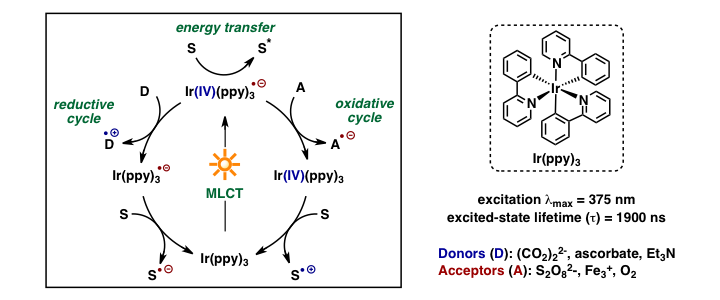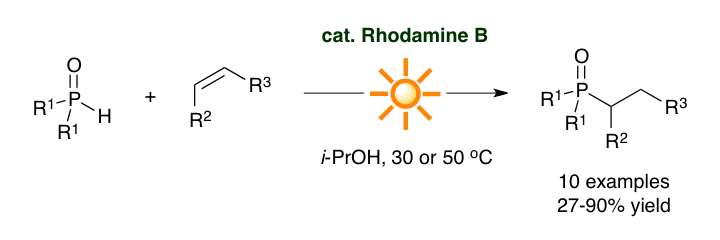
Visible Light Photoredox Catalysis
Harnessing sunlight as a nearly limitless source of energy to facilitate organic transformations is a highly desirable goal for the development of environmentally sustainable organic chemistry. However, the inability of most organic compounds to absorb visible light has limited the use of photochemical reactions. Recently, the emergence of metal polypyridyl complexes and organic dyes as efficient visible light photocatalysts has lead to a renaissance in this field. The purpose of this research is to develop new catalytic systems that can utilize visible light to facilitate challenging organic reactions.
Topics
Polymer-Immobilized Visible Light Photocatalyst

Comment
The synthesis of an iridium-based photocatalyst bearing alkenyl moieties was achieved and this monomeric species was polymerized via a radical polymerization process to provide a heterogeneous visible light photocatalyst. The catalytic activity of this polymer was evaluated for the aerobic phosphonylation reaction of N-aryl tetrahydroisoquinolines under visible light irradiation. It was found that this iridium-based heterogeneous photocatalyst could be recovered and reused up to four times without significant loss of reactivity.
Access to paper
- Efficient Visible Light-Mediated Cross-Dehydrogenative Coupling Reactions of Tertiary Amines Catalyzed by a Polymer-Immobilized Iridium-Based Photocatalyst,
- W.-J. Yoo, S. Kobayashi,
- Green Chem., 16, 2438-2442 (2014). DOI: 10.1039/C4GC00058G
Visible Light-Mediated Radical Addition Reactions

Comment
A visible light-mediated hydrophosphinylation of unactivated alkenes with secondary phosphine oxides was found to occur with good yields and under mild reaction conditions. While our initial screening revealed that metal polypyridyl complexes are excellent catalysts for the C-P bond formation process, it was found that a commercially available and an inexpensive organic dye could be used as a photocatalyst.
Access to paper
- Hydrophosphinylation of Unactivated Alkenes with Secondary Phosphine Oxides Under Visible-Light Photocatalysis,
- W.-J. Yoo, S. Kobayashi,
- Green Chem., 15, 1844-1848 (2013). DOI: 10.1039/c3gc40482j
Visible-Light-Mediated Chan-Lam Coupling Reactions of Aryl Boronic Acids and Aniline Derivatives

Comment
The copper-catalyzed Chan-Lam coupling reaction is an important synthetic method that can be used to construct aryl C-N bonds. However, problems such as high catalyst loadings and limited substrate scope have hindered the use of this method in synthesis. We found that by combining copper catalysis with visible light photoredox catalysis improves Chan-Lam coupling reaction and electron-deficient aryl boronic acids could be utilized as substrates.
Access to paper
- Visible-Light-Mediated Chan-Lam Coupling Reactions of Aryl Boronic Acids and Aniline Derivatives
- W.-J. Yoo, T. Tsukamoto, S. Kobayashi
- Angew. Chem. Int. Ed. 54, 6587-6590 (2015). DOI: 10.1002/anie.201500074

